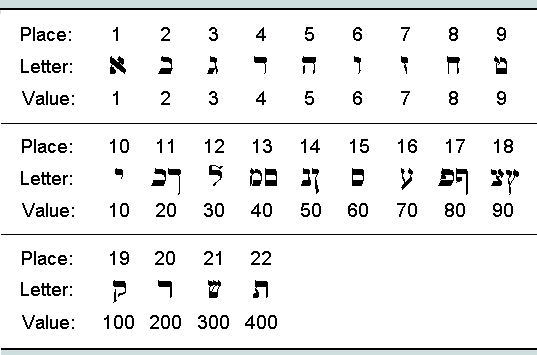
Reading Hebrew and Greek words as numbers
A significant feature of the Christian scriptures - though hardly ever referred to by theologians - is that all translations rest upon Hebrew, Aramaic and Greek originals whose letters and words may also be fairly read as numbers. Evidences of these yesteryear alphabetic numbering systems confront us still - as, for example, on the dials of many townhall clocks and in the verse and chapter numberings of some of the older books on our shelves.
What distinguishes the Hebrew/Aramaic and Greek systems from the Roman are, (a) all (not just the seven: I, V, X, L, C, D and M) alphabetic characters were requisitioned for use as numerals and, (b) the value represented by a string of letters was the simple sum of its constituent parts. Clearly, wherever found, the words of Hebrew, Aramaic and Greek are thereby firmly (and unavoidably) linked with discrete numbers; and though such words may, from time to time, be "interpreted" so as to mean something different from what the author intended, it is clear that the number upon which each rests is an invariant.
Believing that the words of the Scriptures were authored by God himself, it is but a short step to believe also that the numbers we now find indelibly linked with these words were also contrived by him. It follows that Paul's Spirit-led teaching, "All scripture is given by inspiration of God, and is profitable for doctrine, for reproof, for correction, for instruction in righteousness..." (2Tm.3:16), must encompass these numbers, and any information they may be found to convey.
In the following sections the term characteristic value (CV) is used to describe the number obtained by summing the letter-values of a word or portion of text.
The Hebrew/Aramaic scheme of alphabetic numeration

This scheme dates from c200BC. Of the 22 letters, 5 are observed to have alternative end-forms. The first Bible verse to display a numerical structure of interest is Genesis 1:1 - comprising the first 7 of the Torah's 68,504 Hebrew words! Here are the details:

The numerical expression of Genesis 1:1
Reading from right to left we find the 28 individual letter-values inscribed above the words of the text, and their respective sums (the CVs) below. Observe that the untranslatable 4th word indicates that the following noun is the definite and direct object of the transitive verb. This appears again in the latter part of word 6. The verse total (sum of the 7 CVs) is 2701.
There follows a similar analysis of the second verse of the Hebrew Scriptures. This reveals a verse CV of 3546.
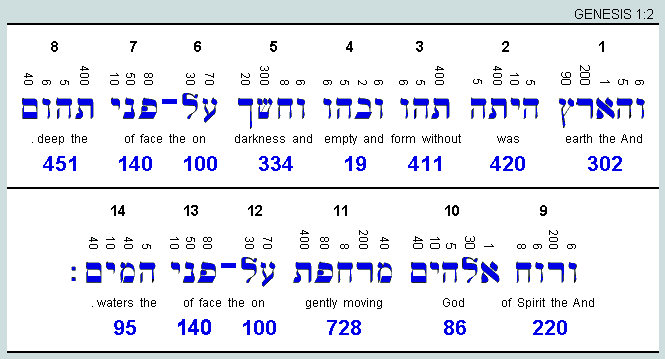
The numerical expression of Genesis 1:2
The Greek scheme of alphabetic numeration
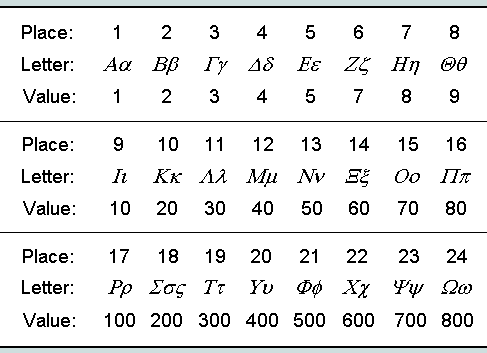
This scheme was instituted before the Hebrew and dates from c600BC. There are 24 letters - presented here as uppercase/lowercase pairs. Observe, (a) that because the values 6 and 90 were represented by non-alphabetic characters, they do not feature in this table, and (b) that the character occupying the 18th position ('sigma') is the only one possessing an end-form. There are two applications of particular interest - the first involving John 1:1 and the second, the Lord's name and title as they appear (nominative case) in the New Testament (interestingly, also in the Septuagint - a Greek translation of the Hebrew of the Old Testament - c300BC!).
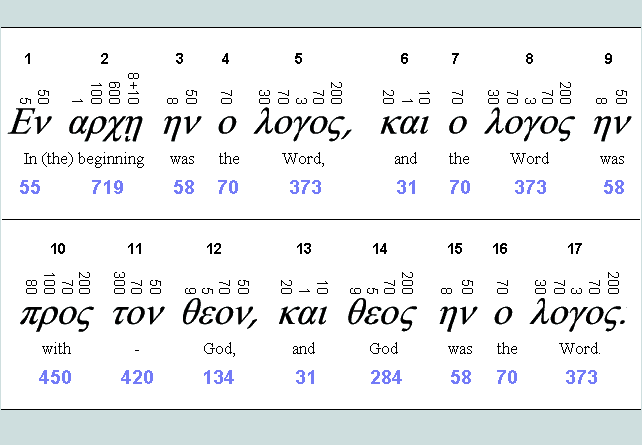
The numerical expression of John 1:1
Here we read from left to right - the17 words comprising a total of 52 letters. Observe that the last letter of the second word is subscripted by another, viz iota, this being the second element of a long vowel dipthong. In fact, therefore, the word has 5 letters; hence the entry "8 + 10" above the dipthong - 8 and 10 being the respective values of letters 4 and 5. The CV for the verse is 3627.
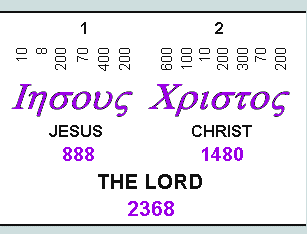
A numerical expression of "The Lord"
To summarize:
Genesis 1:1, the Bible's first verse, has 7 words and 28 letters and is represented numerically by the set of CVs {913, 203, 86, 401, 395, 407, 296} and their sum, 2701
Genesis 1:2 has 12 words and 52 letters and is represented numerically by the set of CVs {302, 420, 411, 19, 334, 240, 451, 220, 86, 728, 240, 95} and their sum 3546
John 1:1 (restating the theme of Genesis 1:1 - the Creation) has 17 words and 52 letters and is represented by the set of 17 CVs {55, 719, 58, 70, 373, 31, 70, 373, 58, 450, 420, 134, 31, 284, 58, 70, 373} and their sum, 3627
The Creator's name and title are represented by the CVs {888, 1480} and their sum, 2368; 13 letters are involved
Vernon Jenkins MSc
2003-08-10
Augmented and corrected 2003-11-25